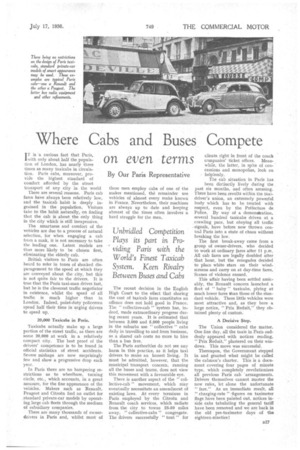Where Cabs and Buses Compete on even terms
Page 37

If you've noticed an error in this article please click here to report it so we can fix it.
By Our Paris Representative
I T is a curious fact that Paris, with only about half the population of Landon, has nearly three times as many taxicabs in circulation. Paris cabs, moreover, provide the highest standard of comfort afforded by the street transport of any city in the world There are several reasons. Paris cab fares have always been relatively low, and the taxicab habit is deeply ingrained in the population. Visitors take to the habit naturally, on finding that the cab is about the only thing in the city which is still inexpensive.
The smartness and comfort of the vehicles are due to a process of natural selection, for when engaging a cab from a rank, it is not necessary to take the leading one. Latest models are thus more likely to be chosen first, eliminating the elderly cab.
British visitors to Paris are often heard to refer in tones of shocked disparagement to the speed at which they are conveyed about the city, but this is not quite fair to the drivers, It is true that the Paris taxi-man drives fast, but he is the cleverest traffic negotiator in existence, whilst the speed of all traffic is much higher than in London. Indeed, point-duty policemen spend half their time in urging drivers to speed up.
20,000 Taxicabs in Paris.
Taxicabs actually make up a large portion of the street traffic, as there are some 20,000 at work in a relatively compact city. The best proof of the drivers' competence is to be found in official statistics of street accidents. Severe mishaps are now surprisingly few and show a progressive drop each year.
In Paris there are no hampering restrictions as to wheelbase, turning circle, etc., which accounts, in a great measure, for the fine appearance of the vehicles. Makers such as Renault, Peugeot and Citroen find an outlet for • standard private-car models by operating large cab fleets through the medium of subsidiary companies.
There are many thousands of ownerdrivers in Paris and, whilst most of these men employ cabs of one of the makes mentioned, thil remainder use vehicles of almost every make known in France. Nevertheless, their machines are always up to date and keeping abreast of the times often involves a hard struggle for the men.
The recent decision in the English High Court to the effect that sharing the cost of taxicab fares constitutes an offence does not hold good in France. The " collective-cab " system has, indeed, made extraordinary progress during recent years. It is estimated that between 5,000 and 5,000 people living in the suburbs use " collective " cabs daily in travelling to and from business, as a shared cab costs no more to hire than a bus fare.
The Paris authorities do not see any harm in this practice, as it helps taxi drivers to make an honest living. It must be admitted, however, that the municipal transport concern, running all the buses and trams, does not view this movement with a favourable eye.
There is another aspect of the " collective-cab " movement, which may eventually necessitate an amendment of existing laws. At every terminus in Paris employed by the Citroen and Renault coach services, which radiate from the city to towns 26-50 miles away, " collective-cabs " congregate. The drivers successfully " tout " for clients right in front of the coach companies' ticket offices. Meanwhile, the latter, in spite of concessions and monopolies, look on helplessly.
The cab situation in Paris has been distinctly lively during the past six months, and often amusing. There have been revolts within the taxidriver's union, an extremely powerful body which has to he treated with respect, even by the Prefecture de Police. By way of a demonstration, several hundred taxicabs driven at a crawling pace, but obeying all traffic • signals, have before now thrown central Paris into a state of chaos without breaking the law.
The first break-away catne from a group of owner-drivers, who decided to work at ordinary fares after 11 p.m. All cab fares are legally doubled after that hour, but the renegades decided to place white stars on their windscreens and carry on at day-time fares. Scenes of violence ensued.
This affair having been settled amicably, the Renault concern launched a fleet of " baby " taxicabs, plying at much lower fares than those of the standard vehicle. These little vehicles were most attractive and, as they bore a large notice, " Prix Reduit," they obtained plenty of custom.
A Decisive Step.
The Union considered the matter. One fine day, all the taxis in Paris suddenly appeared with notices reading. " Prix Reduit," plastered on their windows. This move was successful.
Thereupon, the Government stepped in and granted what might be called the cabmen's charter. This is a document covering four pages of minute type, which completely revolutionizes all previous Paris cab 'arrangements. Drivers themselves cannot master the new rules, let alone the unfortunate "fare,' As an immediate result, all " charging-rate " 'figures on taximeter flags have been painted out, notices inside cabs tabulating the general tariff have been removed and we• are back in the old pre-taximeter days of the eighteen-nineties!




















































































